In October 2019, the Indian government permitted Moana Technologies from Hawaii and Aquaculture de la Mahajambre (known as Aqualma, and part of the Unima group) from Madagascar to supply specific pathogen-free (SPF) black tiger (P. monodon) broodstock to India. Likely due to COVID-19, it took until the end of 2020 before the first 2,000 broodstock arrived in two partner hatcheries, Vaishnavi Aquatech (the partner of Moana) and Unibio (the partner of Aqualma). Since the beginning of this year, these hatcheries, primarily Vaishnavi Aquatech, have sold their first 125-135m post-larvae (PL) to farmers who had eagerly placed their orders. Will black really be back? Let’s take a look at the different perspectives and opinions.
Photo 1: Moana’s first batch of broodstock arriving in India
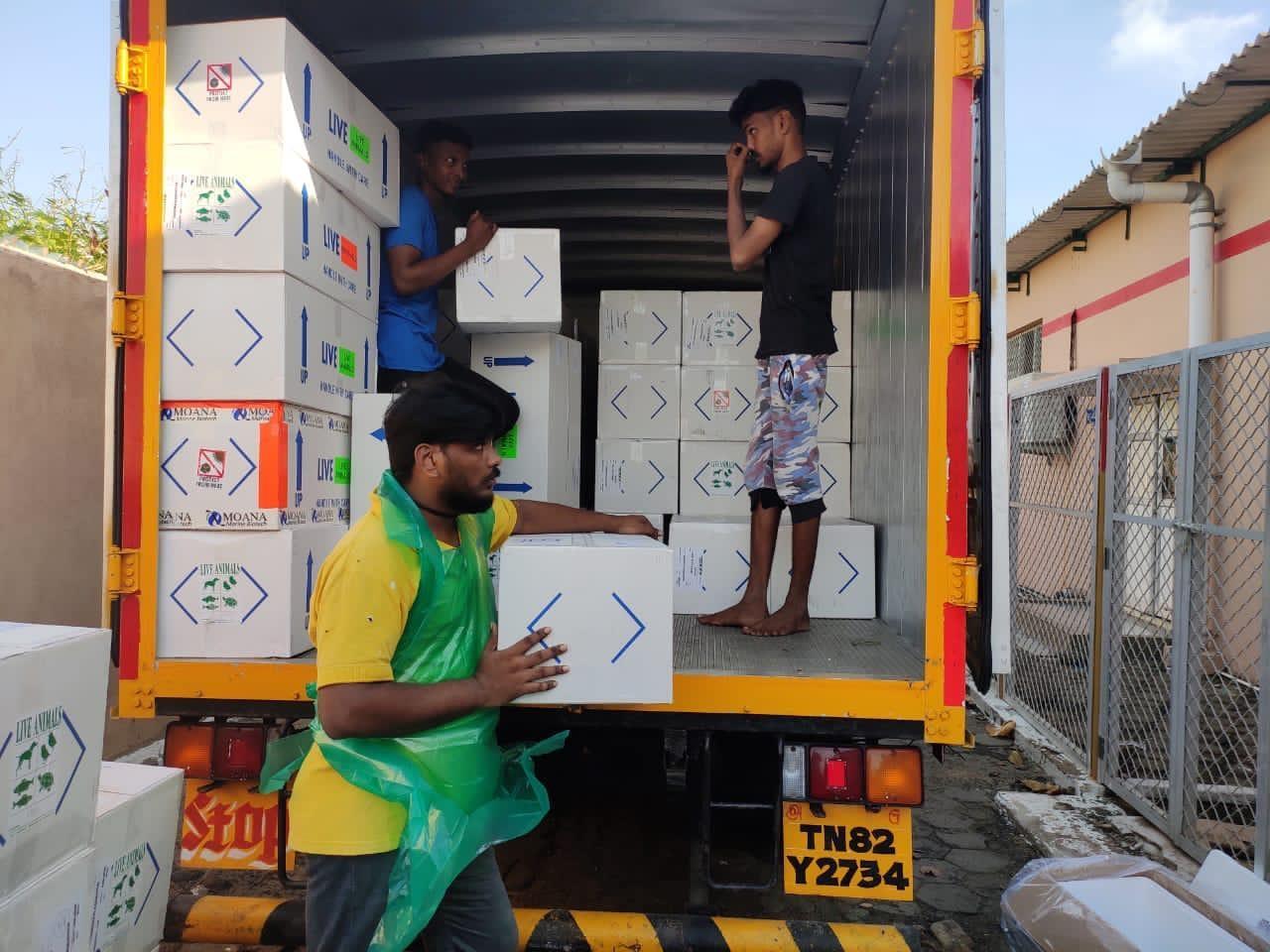
Source: Vaishnavi Aquatech
Thanks to Aditya Dash from Ram’s Assorted Cold Storage Limited, Anwar Sheraz from Abad Overseas, Jorge Sanabria from Nueva Pescanova, Ravi Kumar Yellanki from Vaisakhi, Victor Suresh from the Society of Aquaculture Professionals, Dhaval Contractor from Vaishnavi Aquatech, Panchu Duraisamy from Unibio, Walter Coppens from Moana Technologies and Jaideep Kumar from Aquaculture Spectrum for sharing your views on this topic! And of course, thanks to Skretting, Grobest, API, Inve Aquaculture, Zeigler Nutrition and DSM for sponsoring my blog!
BLACK TIGER SHRIMP: CURRENTLY MOSTLY EXTENSIVELY PRODUCED IN WEST BENGAL
In 2009-2010, India started to experiment with the introduction of L. vannamei. Before that time, India’s coastal shrimp farmers exclusively produced black tiger shrimp. Production was stuck for a long time due to continuous disease challenges, which caused many farmers and investors to lose their appetite for the shrimp industry. When the government permitted the controlled introduction of L. vannamei, it only took a couple of years for most farmers to switch species entirely. At that time, L. vannamei was characterized by higher productivity and less disease prevalence, hence farmers eagerly made the switch. And, as this turned out to be successful, many farmers and investors who had earlier left the industry, decided to return. This made L. vannamei production in India a booming business.
Figure 1: The production volume of black tiger shrimp per state in India from 2009 to 2020
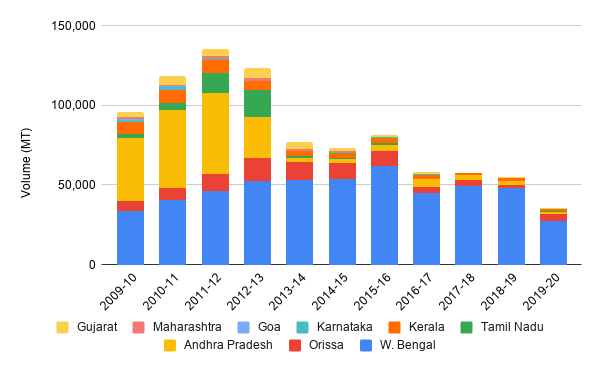
Source: Marine Product Development Authority (MPEDA)
The switch happened to such an extent that, except for a few pockets of semi-intensive farmers in other states, black tiger shrimp was almost exclusively produced by extensive producers in West Bengal and to a lesser extent in Kerala (Figure 1). This is confirmed by the MPEDA’s data showing that while earlier the productivity of black tiger farms in states like Andhra Pradesh and Gujarat was between 5 to 10 MT/ha/year, the remaining area under black tiger culture now has productivity of only 0.5 to 0.7 MT/ha/year. Most of these farmers use traditional trap and hold systems in which they do not use aeration and only use limited amounts of commercial feed. Their PL comes from traditional hatcheries that use wild-caught ready-to-spawn animals.
Some of the current remaining extensive black tiger farms are already or will soon be certified. In one project, based from Kerala, supermarket giant Coop works together with processor Baby Marine and a group of black tiger farmers coordinated by my friend Anil Sasidaran. They aim to produce organic and ASC certified black tiger shrimp for Coop’s supermarkets in the EU. Another project is carried out in West Bengal. Here, Belgium shrimp company Shore works together with local NGOs and processors to produce organic black tiger shrimp for Hofer KG (Aldi Sud). The project in Kerala is still ongoing, but the latest status of the project in West Bengal is uncertain.
I am a faithful supporter of extensively farmed black tiger shrimp. I believe that it’s one of the most sustainable, not to mention tastiest, shrimp you can buy. However, the volume of black tiger shrimp produced in India has become negligible. According to the MPEDA, it came down to 38,000 MT in financial year 2019-2020, well below production in e.g. Vietnam and Bangladesh, but some believe that actual production declined even further.
THE SWITCH TO L. VANNAMEI ERADICATED THE ENABLING ENVIRONMENT FOR BLACK TIGER PRODUCTION
Early 2010, farmers were eagerly looking for a solution to the decline in their productivity due to the widespread prevalence of white spot syndrome virus (WSSV) in black tiger shrimp. Even though the MPEDA established a government-run nucleus breeding center (NBC) and broodstock multiplication center (BMC) on the Andaman Islands, this program is believed to have so far been unsuccessful in producing large numbers of SPF black tiger broodstock. The introduction of L. vannamei happened in the same period. Contrary to black tiger broodstock, L. vannamei broodstock was already supplied as SPF and, as such, transmission of WSSV from broodstock to PL could be avoided. This was a major reason for farmers and hatcheries alike to switch species.
Besides being supplied as SPF, L. vannamei is suited for more intensive production and provides farmers with potentially higher profit margins, making the choice to switch a no-brainer. Hatcheries and processors welcomed the transition as well. Hatcheries because producing quality PL from domesticated L. vannamei broodstock was perceived to be much easier and with the knowledge that farmers were eagerly awaiting a relief from WSSV – as soon as these hatcheries were approved by the Coastal Aquaculture Authority (CAA), most made the switch. Processors had seen their factories run at limited capacity due to the shortage of raw material coming from the farms and therefore were at the forefront of the lobby to introduce L. vannamei. Vertically integrated processors were also the first to pilot L. vannamei farming in their corporate farms. Once approved by the CAA, the processors encouraged others to quickly switch species as they knew that farmers’ productivity could easily double, allowing them to use their total processing capacity and grow export revenue.
Photo 2: Me on a visit to black tiger farms in Andhra Pradesh back in 2011-2012
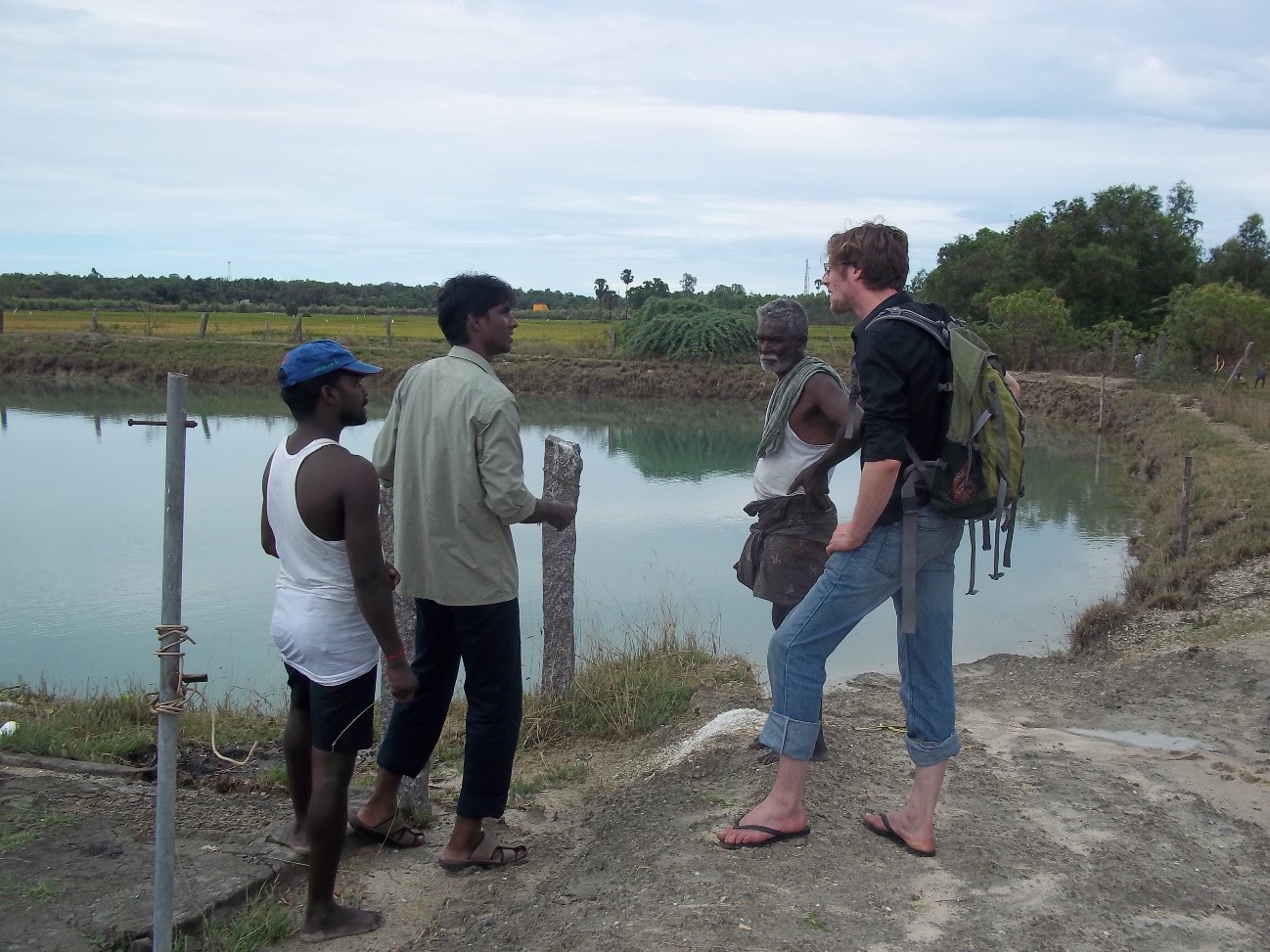
Source: personal
Once L. vannamei broodstock became available, even for farmers who preferred to stick to black tiger shrimp, it became difficult to do so as the industry around them geared towards L. vannamei. Eventually, most semi-intensive farmers made the transition, although some pockets of farmers (e.g. around Guntur in Andhra Pradesh) continued to cultivate black tiger shrimp. They were able to obtain PL from some backyard and commercial hatcheries that continued to use wild-caught ready-to-spawn females to produce PL. In Guntur, each year these undaunted farmers continued to produce 3,000 MT of black tiger shrimp.
But it’s not all happy shrimp farming for the L. vannamei farmers nowadays, either. While the early years of growing L. vannamei shrimp made many Indian farmers a fortune, they got into trouble after a few years, and many are facing difficulties at this moment. L. vannamei-specific diseases and declining L. vannamei prices put farmers in a difficult position. Their margins are being squeezed, and even with a successful crop, farmers struggle to make a profit.
While a few farmers already switched back to black tiger shrimp for a couple of years, for most farmers this was not considered an option as there was no SPF PL available. They rather reduced stocking densities and farming cycles and harvested smaller sizes of L. vannamei instead. However, with prices for small sizes under pressure, many now realize this strategy is most likely unsuccessful in the long run. It took a couple of years of industry lobbying to make the CAA call for an expression of interest for SPF black tiger broodstock suppliers to request a permit for supplying the Indian market. It was this call that resulted in Moana Technologies and Aqualma being granted access to the Indian market in October 2019 with their SPF black tiger broodstock.

BLACK TIGER BREEDING PROGRAMS HAVE MADE BIG GAINS OVER THE PAST 10 YEARS
Jim Wyban, with whom I worked on a recent consultancy assignment concerning black tiger shrimp genetics, once ran a breeding program for black tiger shrimp himself. According to Jim, setting up a domestication program for black tiger shrimp is not easy. All new black tiger shrimp programs face the same problems: chronic mortality and difficulty reproducing. Contrary to the wild, in captivity, black tiger broodstock doesn’t reproduce easily. Although the female will spawn, it’s a struggle to produce sufficient nauplii to develop into the next generation. This only becomes easier once moving beyond the fifth generation but the challenge is to get past that point. According to Jim, once passing the fifth generation-mark, breeding black tiger shrimp appears to be as easy as producing L. vannamei.
Several companies, including Moana Technologies from Hawaii, Aqualma from Madagascar, and CP Foods from Thailand, now run advanced black tiger breeding programs that are all well beyond the 15th generation already. Although there’s little official data out there, all the suppliers claim significant gains in the performance of their animals. They have all achieved SPF status and impressive improvements in growth rates, uniformity and overall disease tolerance. In terms of market shares, Moana and CP Foods presently dominate. CP Foods operates from Thailand and mainly supplies its own hatcheries in Thailand, Vietnam, Malaysia and China. It also sells to third-party hatcheries in countries like Sri Lanka and Bangladesh. Moana has an NBC in Hawaii and operates a BMC in Vietnam. The company sells, among other destinations, to Bangladesh, Indonesia and the Philippines. The two companies combined produced around 80,000 broodstock in 2020, the majority of which comes from Moana. Aqualma has been selling broodstock to hatcheries in Malaysia for several years already and India is the company’s second export market in Asia.
Figure 2: Sample report of ponds stocked with Moana Technologies PL in Guntur, Andhra Pradesh. Last date of sampling at 87 days of culture at 28 April 2021
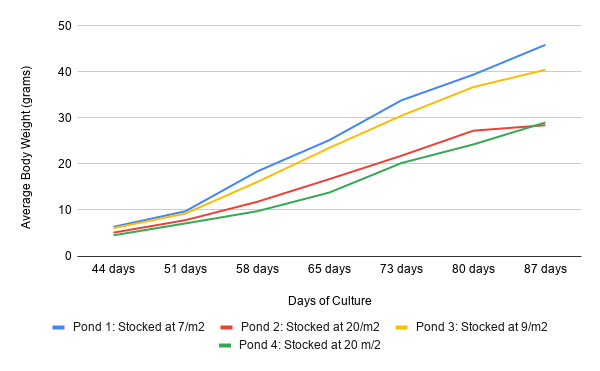
Source: Confidential
With the first crop almost ready for harvesting, field reports on the performance of the PL produced from Moana broodstock by Vaishnavi Aquatech are slowly trickling in. One company involved in supplying black tiger shrimp to a major exporter shared a crop sampling report of one of the farms that he has been buying from. From this report, it is clear that PL stocked at low densities of around 8 PL/m2 have grown to 45 grams in 87 days (Figure 2). At higher stocking densities of around 15 PL/m2, growth was a bit slower and the shrimp reached 30 grams over the same period. At the lower stocking density, the farmer reached a feed conversion ratio (FCR) of 0.73 and 0.79, and in the higher stocking density the farmer achieved FCRs of 1.10 and 1.17. Dharval Contractor of Vaishnavi Aquatech confirms these numbers and shares that in their own farms they will also choose to only stock at low densities as this offers decent profits with limited risks.

WITH IMPROVED GENETICS, SIGNIFICANT VOLUMES OF BLACK MIGHT SOON BE BACK
Currently, the only two black tiger shrimp genetics suppliers that have access to the Indian market are Moana and Aqualma. CP Foods and Topgen, both based out of Thailand, are excluded from the market. As with L. vannamei, the Indian authorities do not permit Thai companies to supply broodstock or PL to India, officially because of worries about disease prevalence in Thailand. There are currently no other SPF black tiger broodstock suppliers out there. Other companies are unlikely to enter the Indian market anytime soon, creating a solid position for Moana and Aqualma and their partner hatcheries Vaishnavi Aquatech and Unibio.
Photo 3: Vaishnavi Aquatech’s hatchery in Andhra Pradesh
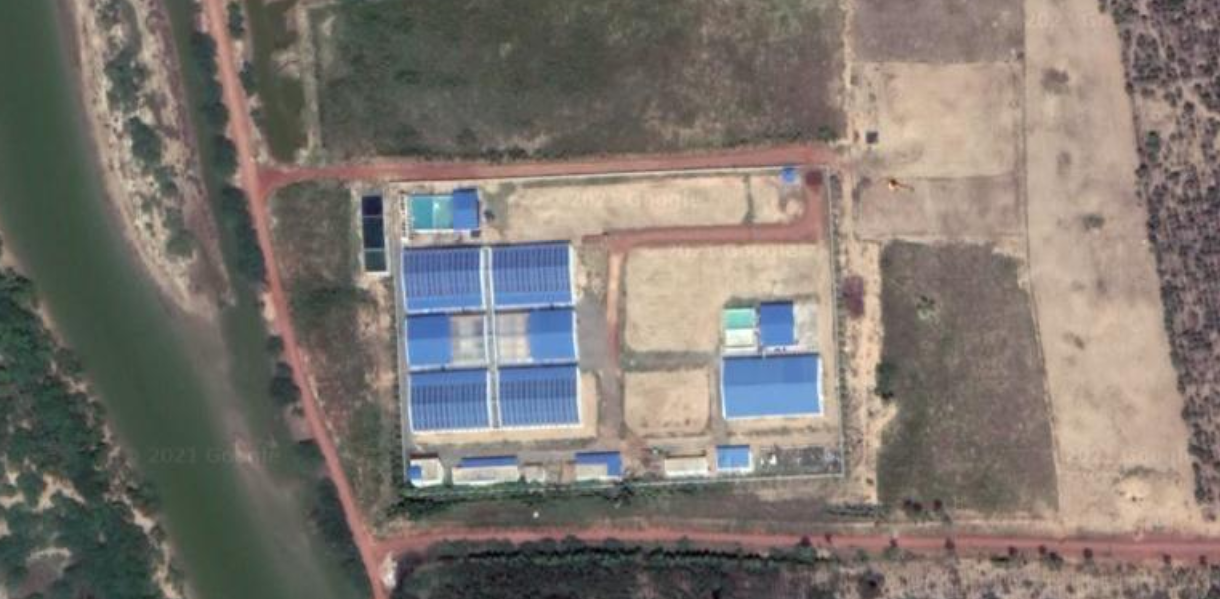
Source: Google Maps
Currently, Vaishnavi Aquatech and Unibio import broodstock, produce PL in their hatcheries and sell those straight to the farmers – these two hatcheries are the farmers’ only option for acquiring SPF black tiger PL. Vaishnavi Aquatech has so far produced 125m PL in its hatchery in Andhra Pradesh and may reach 200m PL by June. In 2022, Vaishnavi Aquatech plans to open two more hatcheries to further increase its production capacity. Besides its hatcheries, Vaishnavi Aquatech also operates 300 ha of black tiger farms in Gujarat which are now fully stocked and from which it could harvest around 1,000 MT in 2021.
In contrast, Unibio has only sold around 10m PL at this point. The company hoped to have produced much more but COVID-19 has caused logistical challenges and production is not yet up to speed. However, once these problems are dealt with, the company will increase its output quickly as there is ample demand for its PL.
Photo 4: Unibio’s first broodstock shipment packed in a charter plane on its way to the hatchery in India
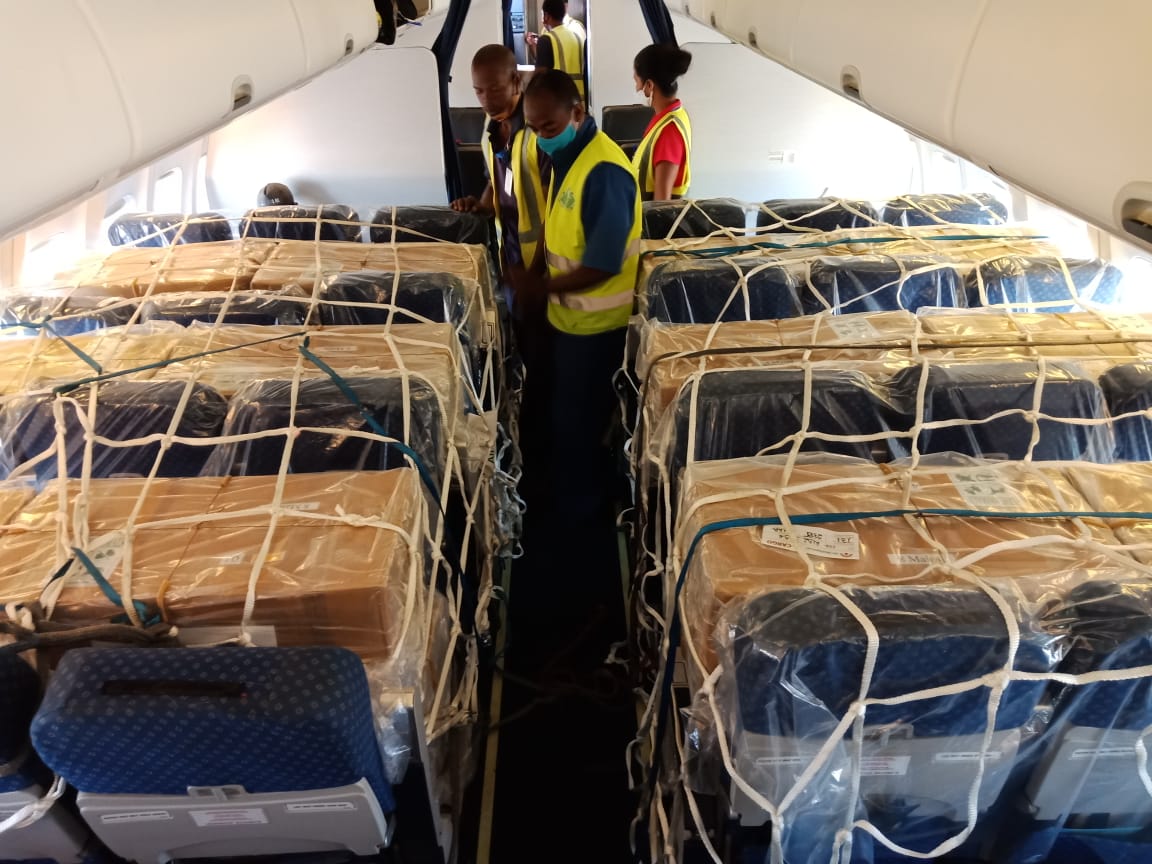
Source: Unibio
These two companies supplying black tiger PL won’t be sufficient to make the species widely available to the farmers across India. At this point, only the happy few have the chance to dip into the possibilities of the new genetics, although this situation may change in 2022. The government has permitted Vaishnavi Aquatech to develop a BMC in Gujarat in India, which is expected to start operations in early 2022. By that time, through the BMC, other hatcheries will also get access to Moana’s broodstock and PL will become more widely available for all farmers. Vaishnavi Aquatech aims to produce 30,000 broodstock in 2022 and gradually increase this number to 52,000 broodstock by 2026. The company eventually aims to not only supply to hatcheries in India but to also export to other countries in Southern Asia and the Middle East.
Photo 5: Design of the Vaishnavi Aquatech’s BMC currently under construction at Degam, Gujarat, India

Source: Vaishnavi Aquatech
Theoretically, with this number of animals, India could produce 11bn PL and 90,000 MT fully grown black tiger shrimp. Although a few lucky farmers may have already got the first taste of being in the black tiger shrimp business, we’ll have to wait until more hatcheries get involved to say that black is really back.
IS THE MARKET READY FOR A POSSIBLE SURGE IN INDIA’S BLACK TIGER PRODUCTION?
India was not alone in its switch to L. vannamei; many other shrimp-producing countries in Asia also made the switch, and only a few continued to produce black tiger shrimp at a significant scale. These include, in order of significance, Vietnam, China, Bangladesh, Indonesia, Malaysia, Sri Lanka and Australia. Although official FAO numbers for global black tiger shrimp production are as high as 700,000 MT, I estimate that black tiger shrimp production is at best anywhere between 400,000 and 500,000 MT and represents only 10-15% of total shrimp production.
As such, black tiger shrimp has increasingly become a niche product. Depending on the market, it’s primarily sold in the EU as a headless shell-on (HLSO) and peeled product for restaurants or as a premium head-on shell-on (HOSO) and HLSO product to markets such as China, Japan and the Middle East. Still, the willingness to pay a better price for black tiger shrimp, especially for the sizes that overlap with L. vannamei, is limited. This is especially the case for the EU. Other markets, such as China and Japan, value the premium quality of black tiger shrimp and will more likely pay the premium price that farmers are hoping for.
Photo 6: First Moana PL produced by Vaishnavi Aquatech being sold to Abad Overseas’ associate farmer in Andhra Pradesh
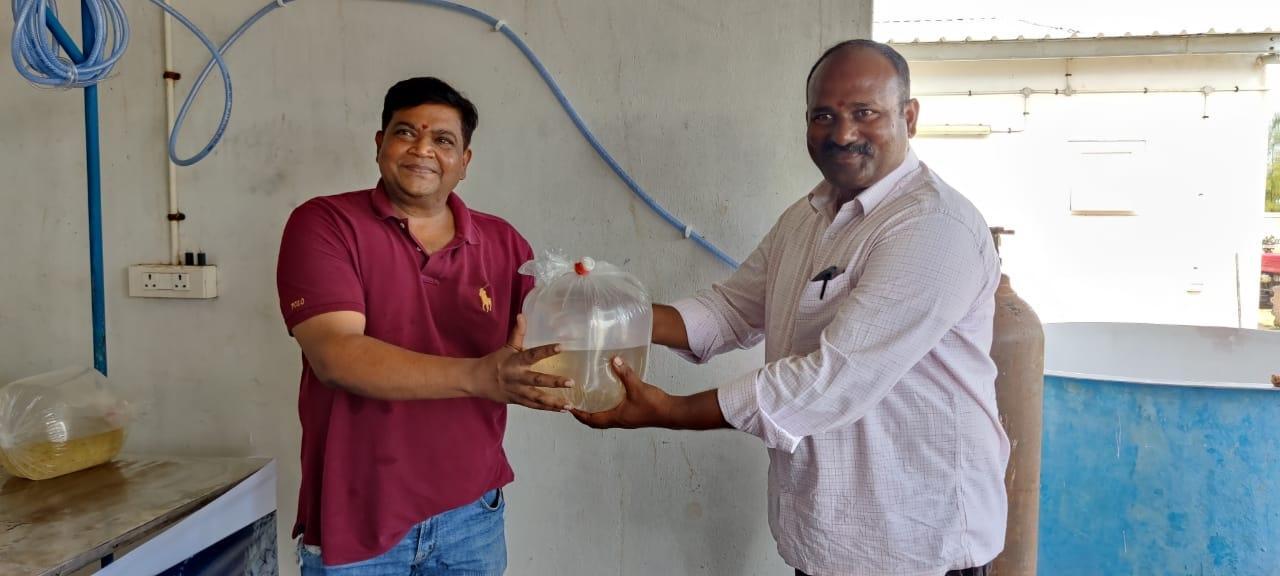
Source: Vaishnavi Aquatech
Anwar Sheraz, Managing Director of Abad Overseas, is enthusiastic about the first crop of black tiger shrimp currently stocked by one of his partners in Guntur. He has high hopes for the future of black tiger shrimp in India and is convinced that 2021 will be a big year for the industry. Abad Overseas is a joint venture partly owned by Nueva Pescanova. Contrary to most other companies in India, Sheraz and his team focus on producing premium HOSO shrimp for high-end markets in China and Europe. Jorge Sanabria, Nueva Pescanova’s Operations Manager, works closely with the team at Abad in Guntur to ensure the quality of the HOSO products from pond to container. Abad is one of the few, if not the only, company in India entirely focused on HOSO products and benefits from the experience of Nueva Pescanova in South and Central America and its vast global sales network.
This year, according to Sheraz, the introduction of Moana’s SPF black tiger shrimp marks a giant leap in the Indian aquaculture industry. Sheraz proudly refers to the first sale of Moana’s SPF black tiger PL through Vaishnavi Aquatech to his associate farmer Issac Kokkiligadda in 2021. Kokkiligadda stocked his ASC certified farms with Moana’s black tiger shrimp at a density of 8 PL/m2 and hopes to harvest at 50 grams by the end of May. Sheraz can’t wait to see these products coming to his factory. He explains that with the shrimp harvested by his associate farmer, he aims to tie up with buyers for ASC certified HOSO black tiger shrimp packaged under a private label for the retail industry in France, the Middle East and Japan.

Four of my contacts at major shrimp buyers in North-Western Europe argue that they would gladly see India step up and produce more black tiger shrimp. Currently, they buy mainly from Bangladesh, but volumes in Bangladesh are coming down and Vietnam’s black tiger shrimp is too expensive for most of the EU market. Previously, black tiger shrimp from India was well appreciated in the EU market, especially by Chinese restaurants. However, since the production of L. vannamei across the globe surged, many of these buyers switched to the cheaper L. vannamei products. Nevertheless, if India can once again produce dark uniform color products, my contacts would be happy to talk with their suppliers to start buying black tiger shrimp in India once again. However, they do warn that in terms of prices, India will have to base its prices on those in Bangladesh, which sells at 0% duty and is not bothered by additional inspections, which India’s exports to the EU do face.
Photo 7: One of the first harvests of black tiger shrimp in Andhra Pradesh produced from Moana’s broodstock
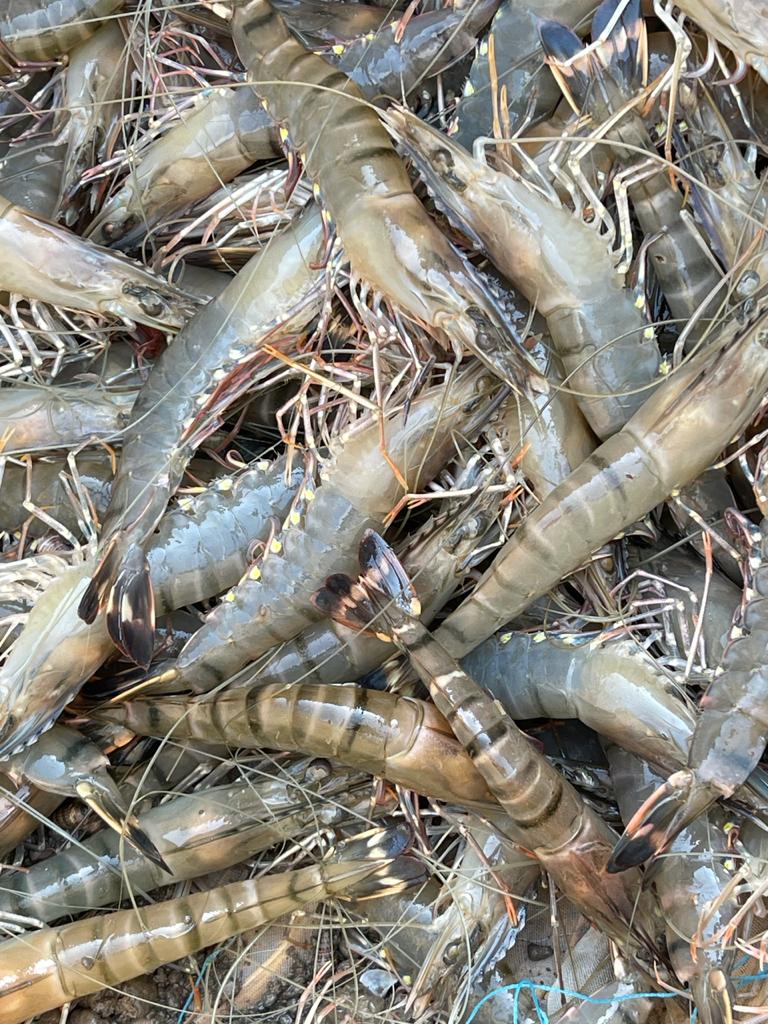
Source: Nueva Pescanova
With the EU probably not being able to meet farmers’ expectations in terms of prices and the US having little interest in black tiger shrimp at all, China (besides Japan) may be the place to go. China has a premium market for high-quality black tiger shrimp. Black tiger shrimp is high in demand, which is not only illustrated by China’s imports from Vietnam but also by the statement of CP Foods’ Robins McIntosh who has said that he sees China as the largest market with the quickest growth potential for its black tiger broodstock. Therefore, I do believe that if branded and marketed the right way, Chinese buyers may be willing to pay the price that India’s farmers who are hoping to make the switch back to black worthwhile.

CONCLUSION
When I asked Victor Suresh from the Society of Aquaculture to review my blog, he expressed his expectation that black will really be back:
India embraced SPF L. vannamei because it was easier to farm at higher densities. The success of L. vannamei farming increased land lease prices for shrimp farms which then drove farmers to increase the stocking density. This cycle is now broken due to production challenges. Farmers are going for lower densities, shorter cycles and aim at producing smaller shrimp. At some point, they will find that this production method favors black tiger shrimp over L. vannamei. If there is more PL production and lower PL costs, India's shrimp farming pendulum will start swinging towards black tiger. The romantic notion of cultivating black tiger among the shrimp farming fraternity will also help the sector revive.
Although I share Victor’s romantic notion of cultivating black tiger shrimp, reminding many of the good old days, I do feel somewhat uncertain from a market perspective. I hope that India’s farmers and exporters will work together to build a brand that will help the farmers get the prices they’re hoping for.